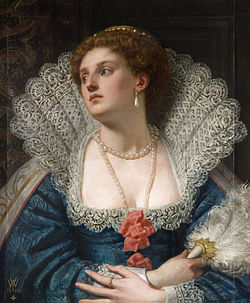A tragic accident or murder? the sad death of Amy Robsart
- Maria Margarita

- Sep 8
- 4 min read

Fantasy portrait of Amy Robsart © William Frederick Yeames (1870)
On Sunday, the eighth of September in 1560, during the bustle of a local fair in Abingdon, tragedy struck at Cumnor Place. Amy Robsart, wife of Robert Dudley, a rising figure and favourite in the court of Queen Elizabeth I, was found dead at the foot of a staircase. Her neck was broken. She was alone in the house, and the cause of death has remained the subject of speculation for centuries.
The location and manner of Amy’s death immediately raised eyebrows. Though accidents on staircases were not uncommon, and many contemporaries (and later scholars) accepted the possibility of a tragic fall or even suicide, the surrounding political context made the situation far murkier. Robert Dudley, who was at Windsor Castle with Queen Elizabeth at the time, was informed of his wife's death by a messenger on 9 September. He quickly wrote to his steward, Thomas Blount, who had just departed for Cumnor, instructing him to investigate the scene thoroughly.
Amy Robsart and Robert Dudley are generally believed to have first met in August 1549, at Stanfield Hall in Norfolk, Amy’s family home. Both were only 17 years old, born within weeks of each other in June 1532.
At the time, Dudley’s father, John Dudley, Duke of Northumberland, was one of the most powerful men in England, rising rapidly under the reign of Edward VI. That summer, the elder Dudley arrived in Norfolk to suppress Kett’s Rebellion, a local uprising against enclosure and economic hardship. His entourage included his fifth son, Robert, who was seeing his first taste of military action and, by some accounts, his first experience of love.
Within months, Robert and Amy were married. It was a union that seemed genuine in its early stages, but one that would become increasingly strained as Robert’s court career progressed and Amy was left behind, living apart from her husband for much of their married life.
By the late 1550s, Robert Dudley had become one of Queen Elizabeth’s most favoured courtiers. So favoured, in fact, that rumours of a romantic relationship swirled around the court and across Europe. Amy’s sudden and suspicious death only added fuel to those fires. With the aftermath of her death, whispers of scandal began circulating almost immediately. Rumours about the Queen and her favourite caused, as contemporary observers put it, “grievous and dangerous suspicion, and muttering” across the realm. Robert himself was reportedly devastated, dreading “the malicious talk that I know the wicked world will use.”
That talk did indeed spread quickly. William Cecil, Elizabeth’s closest advisor and Principal Secretary, had long viewed Dudley with mistrust. Fearing the possibility of Dudley marrying the Queen and becoming king consort, Cecil quietly encouraged gossip and planted seeds of doubt in the minds of foreign ambassadors and domestic allies alike.
One of Cecil’s most damning moves was informing the Spanish ambassador, before Amy’s death was even officially made public, that Robert and the Queen intended to marry and that Amy Dudley’s demise had been carefully arranged. According to the ambassador’s reports, he was told that Lady Dudley was not truly ill, as had been claimed, but rather had been “done away with” by poison.
Nicholas Throckmorton, the English ambassador to France and another staunch opponent of a Dudley-Elizabeth match, also played his part. At the French court, he made sure to highlight the scandal, reporting gleefully on the rumours that Elizabeth had conspired in the murder of her rival in love.
Yet despite their political manoeuvring, neither Cecil nor Throckmorton appears to have believed that Robert Dudley actually orchestrated his wife’s death. Their actions were more about weaponizing public perception than revealing any clear truth. The scandal, whether founded or not, served their political goals.
The fallout from Amy Robsart’s death was swift and severe. Though no formal charges were ever brought against Dudley, and a coroner's jury ultimately ruled the death an accident, the cloud of suspicion lingered over him for the rest of his life. Any realistic hopes of marriage to the Queen if indeed they ever existed were shattered.
For Elizabeth, it marked a turning point. Though she continued to favour Dudley, eventually making him Earl of Leicester, she never married. Amy’s death had tainted the prospect of union, not just in public opinion, but in political practicality. The Queen’s virginity, once a topic of gossip, became a political weapon and eventually a national mythos.
Centuries later, the truth of what happened to Amy Robsart remains elusive. Historians have floated multiple theories: a tragic accident; a calculated suicide; or, perhaps most intriguingly, a murder carried out by overzealous courtiers acting without Dudley’s knowledge to clear the way for a royal match.
Whatever the truth, Amy's death was not just a personal tragedy. It was a moment that reshaped the Tudor court, altered the political trajectory of Elizabeth’s reign, and left a stain on one of the most enigmatic figures in English history. Her death remains, like so much of Tudor politics, an unsolved puzzle that is woven from ambition, fear, and the dangerous intersection of love and power.
Resources:
Susan Doran, Monarchy and Matrimony: The Courtships of Elizabeth I (1996)
Simon Adams, Ian Archer, and G.W. Bernard “A 'Journall' of Matters of State happened from time to time as well within and without the Realme from and before the Death of King Edw.the 6th untill the Yere 1562” in Ian Archer (ed.): Religion, Politics, and Society in Sixteenth-Century England pp. 35–122 Cambridge University Press (2003)
Chris Skidmore, Death and the Virgin: Elizabeth, Dudley and the Mysterious Fate of Amy Robsart (2010)
Derek Wilson, Sweet Robin: A Biography of Robert Dudley Earl of Leicester 1533–1588 (1981)
Sarah Gristwood, Elizabeth and Leicester: Power, Passion, Politics (2007)



Comments